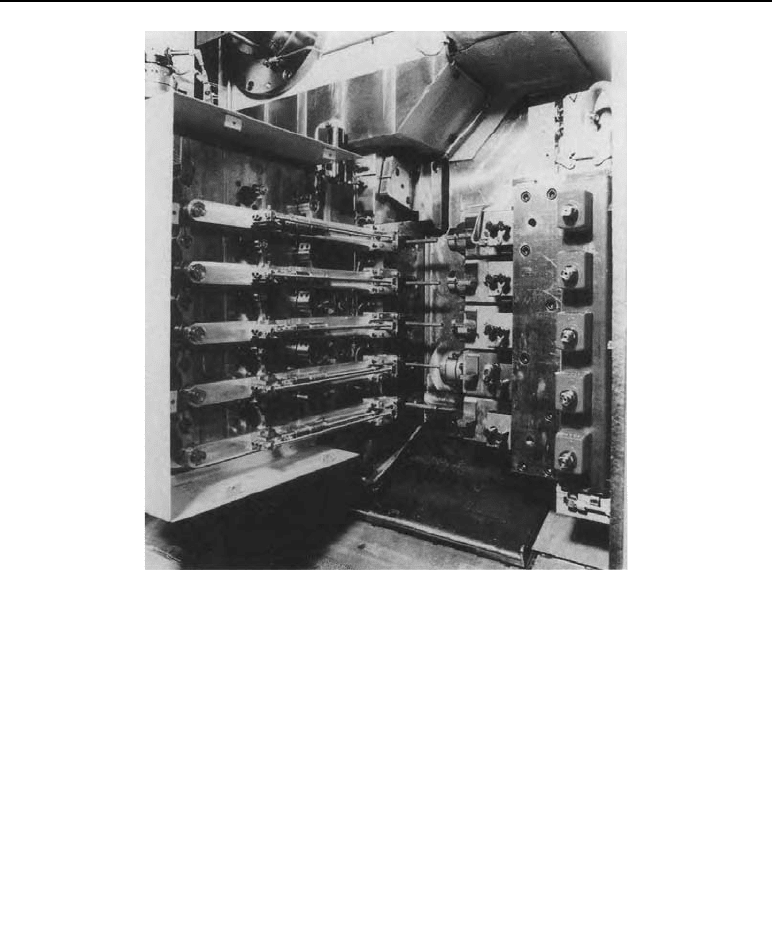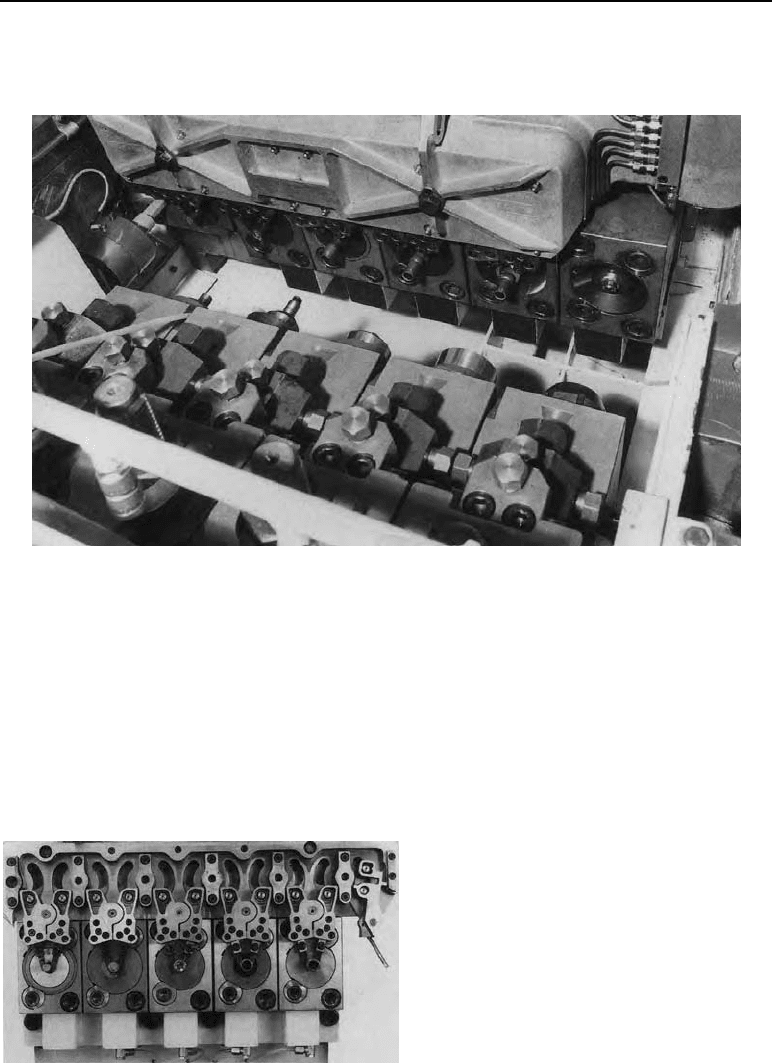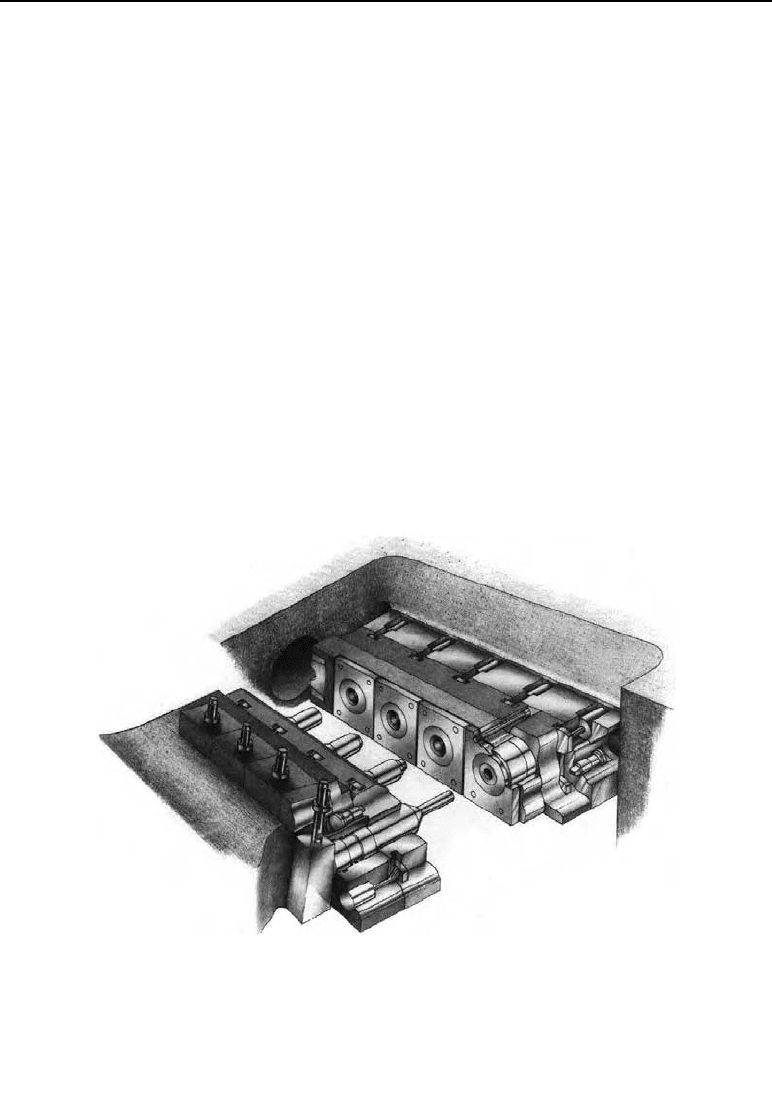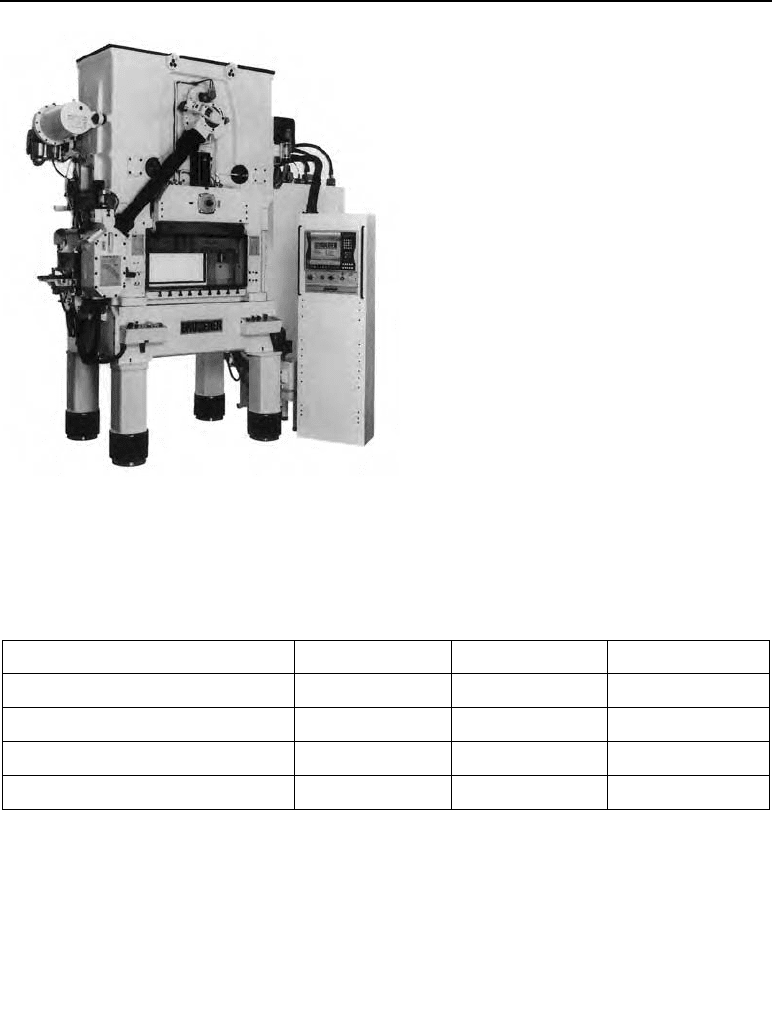Tsch?tsch H., Koth A. Metal Forming Practise: Processes - Machines - Tools
Подождите немного. Документ загружается.


27.2 Transfer presses for bulk forming 331
27.2 Transfer presses for bulk forming
Unlike vertical transfer presses, which are used mainly for sheet forming, horizontal transfer
presses were developed for bulk forming.
They are cost-effective when workpieces requiring several working operations need to be
produced in large quantities, and when the tooling can be controlled in terms of its useful life.
After shearing, different manufacturing processes are carried out in the individual press sta-
tions (e.g. Station 1 upsetting, Station 2 extrusion, etc.). As the industry for standard parts
(screws and bolts, nuts and rivets) always requires parts on a large scale, that is where presses
of this kind first became established. Today transfer presses are used to manufacture all kinds
of bulk-formed parts. These presses are categorised according to
1. the number of stations into two-stage, three-stage, four-stage and multi-stage presses,
2. tooling arranged horizontally or vertically,
3. fields of application
e.g. presses for screw and bolt manufacturing,
presses for nut manufacturing,
presses for formed parts of various kinds, e.g. valve spring retainers.
Figure 27.7 shows a two-stage press. This press has a shearing stage and two working stations.
Figure 27.7 (above) Two-stage press (Photograph: Hilgeland
works, Wuppertal, Germany)
Figure 27.7a (right) Sequence of operations on a two-stage
press
The head of a screw, for example, can be upset and finished in the two working stations (see
also Chapter 4 Figure 4.7). The front feed of the press guides the wire from the coil through a
wire straightener and then pushes the straight wire on to the shearing stage. Here it is cut to the
required length. A gripper brings the wire section to the press die set. After forming, the fin-
ished workpiece is automatically knocked out by the ejector.

332 27 Special-purpose presses
Figure 27.8 shows the drive layout for this press:
Figure 27.8 Drive layout of a CH 1 SH two-stage press (Illustration: Hilgeland works, Wuppertal,
Germany)
The eccentric shaft 1 drives the slide stroke via the connecting rod, and at the same time pow-
ers the drive of the control shaft 3 via a transmission gear 2 and bevel gears.
The shearing system 4 is operated by means of cams from the control shaft, and the ejector is
operated using more bevel gears 5 and a pivoted lever 6.
Via a link block 8, the same transverse shaft 7 drives the wire infeed rollers 9 which also pull
the wire through the straightening rollers 10 and then push it into the shearing bush.
The “Formmaster FM-350” press shown in Figure 27.9 is a transfer press with a vertical tool
layout.
The press body is a box frame which holds the gears and the ejector mechanism in a closed
casing. This keeps the elements of the driving gear, running in an oil bath, safely separated
from the tooling area. The highly rigid construction of the body was optimised using the Fi-
nite-Element Method. The ram, which holds the punch, is guided by rollers with no play at any
level. In this press, the working stages are arranged one above the another and the die sets are
set up vertically (Figure 27.10). This is a great advantage for tool changing as the tooling is
easy to access. They can also be monitored well and maintenance is easy.
The punch holders on the front side of the ram can be adjusted at three levels as relates to the
die axle.

27.2 Transfer presses for bulk forming 333
Figure 27.9 Formmaster FM-350 transfer press with five forming stages and one shearing stage
(Photograph from Formatech GmbH works,Willich-Münchheide, Germany)
For the transfer press shown in Figure 27.9, a program-controlled tool-changing system is
available, among other things.
Figure 27.10
Vertical arrangement of the punch in adjustable tool
holders
(Photograph from Formatech GmbH works,Willich-
Münchheide, Germany)

334 27 Special-purpose presses
The fact that the punch holder and punch can be precisely adjusted and the ram is guided with
no play guarantees consistently small tolerances in the finished part and long tool lives. The
manufacturing plants typically used in bulk forming are capital-intensive, and their cost-
efficiency depends crucially upon the percentage of the total production time taken up by non-
productive time and set-up time. Here, tool changing and set-up systems can make a vital con-
tribution to shortening these non-productive times and lengthening the time the press is in
action.
As manufacturing structures can differ greatly as concerns part size, lot size, processing and
the manufacturing sequence, various systems for fast tool changing are available on the mar-
ket: the operator can choose a combination suited to the operation.
With this tool-changing system all the tooling is adjusted and changed fully automatically
when the press set-up is changed. This reduces changeover times drastically. The result is
flexible manufacturing which means these presses can also be used economically for smaller
lot sizes.
The die block, shearing block and punch blocks, which are mounted on a single die plate, are
changed as one unit. The press is equipped with a special device to help carry out the change.
The die block and the die plate are clamped in place with quick-action hydraulic devices which
can easily be released.
The shearing blade, shearing bush, punch and die can still be changed separately, independ-
ently of this fast tool-changing system.
The tooling being changed can be adjusted before it is mounted in the press. For this purpose
the press has a tooling support area for adjusting tools, and a fixed holder for the die block and
die plate, as well as appropriate adjustment devices.
The optimum settings for the X, Y and Z coordinates of a workpiece are determined once for
every stage and then saved in the tooling databank. When the tooling is changed, these saved
parameters can be called up at any time, even when the work is not being done on the press.
This makes tool changing faster, easier and safer. When the conditions of a process are the
same, sound parts are produced right from the first strokes. With this system, a program ad-
justs peripheral units: this is fully automatic. The ejector stroke and return stroke are adjusted
with a motor. The feed system is set up to fit a wide range of diameters so that the grippers do
not need changing when production is switched over.
A numerically controlled transfer system (Figure 27.11) is used to transport the workpieces
within the press. The transfer system and grippers are operated by individually-controlled
electric servo drives. The settings are adjusted using a menu í it is no longer necessary to
change camshafts or adjust cams. These settings are saved in a tooling databank and can be
called up when needed within seconds.

27.2 Transfer presses for bulk forming 335
Figure 27.11 NC transfer unit (Photograph from Formatech GmbH works, Willich-Münchheide, Ger-
many)
When single gripper jaws are replaced, a complete magazine is changed which can be pre-
adjusted outside the press using an adjustment gauge.
Another important way to reduce machine down time is to fit the press with the Coros Opera-
tor Panel operating system. With this system, operating and fault messages give the operator a
comprehensive overview of the status of the unit. When he selects the Setup í Operation í
Tool Change operating mode, the menu-driven user guide leads him through the process until
the press is ready for operation.
All operating and fault messages are clearly worded and archived, making long-term failure
analysis possible. The tooling data specific to each part are archived in the tooling databank
and can be called up at any time.
Figure 27.12 shows typical workpieces which can be produced on this kind of transfer
press.

336 27 Special-purpose presses
Figure 27.12 Typical workpieces for transfer presses (Photograph: Formatech GmbH works,Willich-
Münchheide, Germany)
Figure 27.13 shows a state-of-the-art transfer press with a shearing station and five forming
stages.
Figure 27.13 High-performance transfer press with five forming stages and an integrated shearing
station (Photograph: Hatebur works, Reinach, Switzerland)
In this press, which works from a wire coil, the die sets are arranged horizontally. Four feed
rollers draw the wire (14 to 27 mm diameter) into the press via a roller straightener which
straightens the wire, until it reaches the stock feed stopper on the shearing machine. In the
shearing station (Figure 27.14) the sections of wire are sheared without burring to the length
required for the workpiece. The length of the sections is monitored electronically in the

27.2 Transfer presses for bulk forming 337
press. The wire stopper, which determines the length of the section, can be adjusted during
operation. When there is a deviation in the measurements, the press automatically turns off.
Figure 27.14 Tooling area of a transverse feed transfer press (Photograph: Hatebur works, Reinach,
Switzerland)
In the destacker station, the sections are pushed out of the shearing bush and taken up by the
first gripper (Figure 27.15) on the transverse transport system, which transports the blank as
far as the first forming stage. In the following five forming stages, the blank is then formed by
the five die sets (punch and die) until the workpiece is finished. The grippers transport the part
in a straight line to the next forming stage. There, they rise up and, as the forming takes place,
move back above the punch.
Figure 27.15
Gripper system on a five-stage transverse
feed press
(Photograph from Hatebur works, Rei-
nach, Switzerland)
In the last stage of forming, the finished part is then ejected. Depending upon the thickness of
the wire, 80 to 210 workpieces per minute can be produced on this press.

338 27 Special-purpose presses
Constructional design of the presses
The basic body of the press is a closed bend- and twist-resistant frame which is cast in one
piece. The pressure pad the dies are mounted on is strengthened with hardened, replaceable
armour plating. The press slide has long guides in front of and behind the crankshaft. The
slight play is practically negated by a high-pressure oil circulation lubrication system, which
presses the oil into the guide paths. Labyrinth seals protect the guides at the front of the work-
ing area against coolant, abrasion and particles from the workpiece.
The crankshaft throw is as wide as the whole slide. The H-shaped double connecting rod is
also the same width. This means that the slide support across all five forming stages is such
that even an asymmetrical press force does not impair the accuracy of the slide guidance.
The drive is fully variable. A safety stop can bring the press to a halt by means of an electro-
pneumatic clutch/brake device within 90° of a shaft rotation. This protects the tooling against
damage (fracture). The stroke depth and time of the ejectors which knock the workpiece out of
the press can be adjusted separately for each die set.
The tooling can be changed within 60 minutes with the fast tool-change system. The tooling
modules (Figure 27.16) are exchanged as a single block, meaning that only fine adjustments
have to be made in the press.
Figure 27.16 Interchangeable fast tool change block (Photograph from Hatebur works, Reinach, Swit-
zerland)
The tooling blocks are prepared outside the press and preset so as not to cause machine down-
time. Figure 27.17 shows typical parts produced on this press.

27.3 Automatic punching presses 339
Figure 27.17 Sequence of operations for a spark plug barrel produced on a Coldmatic transfer press
(Photograph from Hatebur works, Reinach, Switzerland)
The machine is controlled from a control desk combining all display and control devices.
Operating errors are practically impossible as all the main switching functions are interdepen-
dently locked.
Table 27.1 Technical specifications
Max. wire diameter in mm
at 600 N/mm tensile strength
14 – 27
Section length in mm
6 – 170
Number of strokes in
min
–1
80 – 120
Nominal press force in kN
850 – 3500
Press force per step in kN
350 – 1500
Drive power in kW
35 – 110
27.3 Automatic punching presses
In Chapter 19, Figure 19.5, there is a description of an automatic fine punching press. This
section presents an automatic punching press, Figure 27.18, designed for particularly high
stroke rates. With these extreme stroke rates, large mass forces occur due to the bidirectional
movement of the masses.
2
m
29.55
Hn
Fm
§·
¨¸
©¹
F
m
in N mass force
m in kg mass of the moving parts
n in min
–1
stroke rate
H in m stroke length
These mass forces not only put a stress on the bearing and guides, they are also transmitted
onto the floor of the hall.

340 27 Special-purpose presses
Figure 27.18
BSTA 50 automatic punching press with
mass counterbalancing
(Photograph from Bruderer works, CH-9320
Frasnacht, Switzerland)
For these fast-running punching presses, mass counterbalancing is therefore needed if the total
mass of the ram and the upper part of the die set exceeds 200 kg.
Table 27.2 Technical specifications for automatic punching presses
Press type BSTA 20 BSTA 50 BSTA 110
Nominal press force in kN
200 500 1100
Max. stroke rate in min
–1
1800 1200 850
Stroke length in mm
8 – 38 16 – 51 16 – 75
Stroke adjustment in mm
50 64 89
In the Bruderer mass counterbalancing system (Figure 27.19) the movement of the ram 1 is
transferred relative to the tooling bolster plate 2, e.g. on the downwards working stroke; the
force produced by the eccentric 6 is increasingly transmitted via the connecting rod 5 and the
lever 4 to the column of oil 3 and so on to the ram 1. As a result of acceleration one mass force
acts in an upward direction. At the same time the counterweights 9 carry out an upward
movement by means of the rod 7 and the mass counterbalancing lever 8. These mass forces
counteract and balance out the mass forces from the ram.
The horizontal mass forces from the eccentric parts must also be balanced out, or the press
lurches. These mass forces are balanced out by a counterweight using rod 10 and lever 11,
with the centre of gravity of the counterweights moving in an ellipse, every point of which
corresponds to the resultant of both forces.
